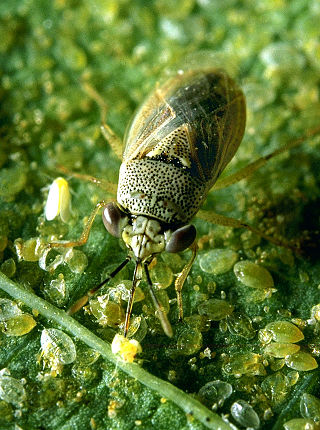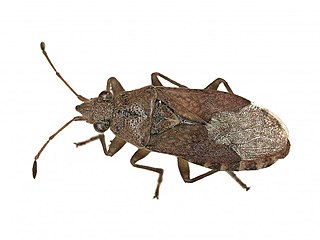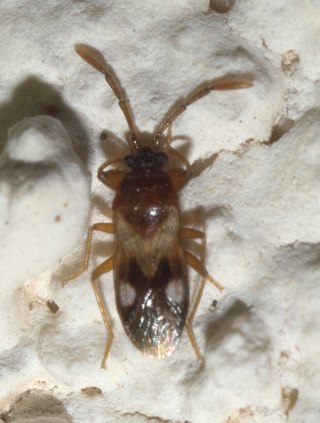
Geocoris is a genus of insects in the family Geocoridae. Commonly known as big-eyed bugs, the species in Geocoris are beneficial predators, but are often confused with the true chinch bug, which is a pest. There are more than 140 described species in Geocoris.

The Lygaeoidea are a sizeable superfamily of true bugs, containing seed bugs and allies, in the order Hemiptera. There are about 16 families and more than 4,600 described species in Lygaeoidea, found worldwide. Most feed on seeds or sap, but a few are predators.

The Lygaeidae are a family in the Hemiptera, with more than 110 genera in four subfamilies. The family is commonly referred to as seed bugs, and less commonly, milkweed bugs, or ground bugs. However, while many of the species feed on seeds, some feed on sap (mucivory) or seed pods, others are omnivores and a few, such as the wekiu bug, are carnivores that feed exclusively on insects. Insects in this family are distributed across the world. The family was vastly larger, but numerous former subfamilies have been removed and given independent family status, including the Artheneidae, Blissidae, Cryptorhamphidae, Cymidae, Geocoridae, Heterogastridae, Ninidae, Oxycarenidae and Rhyparochromidae, which together constituted well over half of the former family.

Nysius is a genus of false chinch bugs in the family Lygaeidae. At least 100 described species are placed in Nysius.

Berytidae is a family of the order Hemiptera, commonly called stilt bugs or thread bugs. Most berytids are brown to yellow, with species that are plant sap feeders, a few being predaceous. About 200 species are known from all around the world and they are classified into three subfamilies.

Heterogastridae is a family of lygaeoid bugs consisting of about 20 genera and more than 100 species.

The Blissidae are a family in the Hemiptera, comprising nearly 50 genera and 400 species. The group has often been treated as a subfamily of the Lygaeidae but was resurrected as a full family by Thomas Henry (1997).

Orsillini is a tribe of seed bugs in the family Lygaeidae. The type genus is Orsillus.

Myodochini is a tribe of dirt-colored seed bugs in the family Rhyparochromidae. There are more than 80 genera and 370 described species in Myodochini.

Cymidae is a family of true bugs in the order Hemiptera. There are about 12 genera and at least 60 described species in Cymidae.

Geocoridae is a family of big-eyed bugs in the order Hemiptera. There are more than 290 described species in Geocoridae.

Metacanthinae is a subfamily of stilt bugs in the family Berytidae. There are about 12 genera and 80 described species in Metacanthinae.

Tempyra is a genus of dirt-colored seed bugs in the family Rhyparochromidae. There are at least two described species in Tempyra.

Oncopeltus is a genus of seed bugs in the family Lygaeidae, which has at least 40 described species.
Paromius is a genus of dirt-colored seed bugs in the family Rhyparochromidae. There are about 15 described species in Paromius.

Xyonysius is a genus of seed bugs in the family Lygaeidae. There are about eight described species in Xyonysius.

Pseudopachybrachius is a genus of dirt-colored seed bugs in the family Rhyparochromidae. There are about eight described species in Pseudopachybrachius.

Ischnorhynchinae is a subfamily of seed bugs in the family Lygaeidae. There are about 16 genera and more than 70 described species in Ischnorhynchinae. The members of this subfamily are small, terrestrial insects that typically translucent or transparent plate-like structures covering the thorax (pronota) and tend to live in plant flowers.

















